
Table Rock State Park is a 3,083-acre (12.48 km2) park at the edge of the Blue Ridge Mountains in northern Pickens County, South Carolina. The park includes Pinnacle Mountain, the tallest mountain totally within the state.
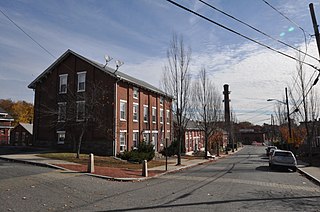
Lonsdale is a village and historic district in Lincoln and Cumberland, Providence County, Rhode Island, United States, near Rhode Island Route 146 and Route 95. The village was originally part of the town of Smithfield until Lincoln was created in the 1870s, and was originally centered on the Lincoln side of the river. William Blaxton settled in the area in 1635. In the nineteenth and early twentieth centuries, Lonsdale was home to several manufacturers including the Lonsdale Company's Bleachery, and the Ann & Hope mill was also located in the village in Cumberland.

Saylesville is a village and historic district in Lincoln, Rhode Island.
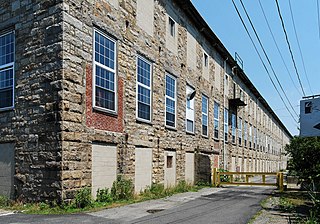
Fall River Bleachery is an historic textile bleachery on Jefferson Street in Fall River, Massachusetts.

This is a list of the National Register of Historic Places listings in Beaufort County, South Carolina.

This is a list of the National Register of Historic Places listings in York County, South Carolina.
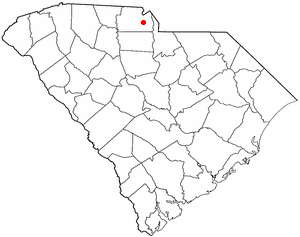
This is a list of the National Register of Historic Places listings in Rock Hill, South Carolina.

The W.L. Hill Store, built in 1913, is an historic three story department store located on York Street in the town of Sharon, York County, South Carolina. It is by far the largest building in town. Designed in the commercial style, by locally prominent architect Julian Starr, its size and grandeur was meant to mimic larger stores in major cities. On January 20, 1995, it was added to the National Register of Historic Places. It is located in the Hill Complex Historic District.

Southern Bleachery and Print Works is a historic factory building in Taylors, Greenville County, South Carolina. Founded by former Furman University English professor Bennette Geer, and built by the J. E. Sirrine Company of Greenville, the mill operated between 1924 and 1965, with the last historic structure being built in 1952. The property consists of 15 contributing resources, including a main building, warehouses, a smokestack, a detached boiler room with smokestack, a filtration plant, and two ponds. The bleachery acquired unfinished goods produced by other textile mills and converted them by bleaching, dyeing, and finishing into material used to manufacture clothing and other items. A small mill village, including Baptist and Methodist churches, was established nearby, and many mill houses continued to exist into the 21st century.

Gravel Hill Plantation is a historic hunting plantation complex located at Garnett, Hampton County, South Carolina. It was built in 1910, and is the 20-acre core of a large hunting plantation that includes eleven historic buildings; nine of them were designed and built by the owner, Robert Palmer Huntington. The complex includes three residential buildings, a kitchen and dining facility, ice house, stables and ancillary service buildings. Also on the property are a corn crib and a tenant's house. It is a rare example of the Adirondack or Rustic Style in South Carolina.
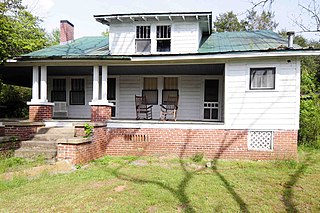
Roper House Complex, also known as Camp Oolenoy and Elizabeth Ellison House, is a historic home located near Pickens, Pickens County, South Carolina. It was built in 1856, and enlarged and remodeled by the Civilian Conservation Corps (CCC) with American Craftsman influences in about 1937. Also on the property are three contributing outbuildings; a smokehouse, garage, and chicken coop. It was the home of Manning Thomas Roper, first superintendent of Table Rock State Park. He also provided the land for both CCC camps and also provided the right-of-way for the original park entrance. In 1952, the Roper House became part of the Table Rock State Park, Camp Oolenoy complex.

Hill Complex Historic District is a national historic district located at Sharon, York County, South Carolina. It encompasses four contributing buildings in Sharon. The buildings are commercial, industrial, and residential buildings built by William Lawrence Hill between about 1890 and 1925. The buildings are the William L. Hill House, W. L. Hill Cotton Gin, W. L. Hill Cotton Warehouse and Dock, and the separately listed W.L. Hill Store (1913).

Rock Hill Body Company, originally known as Victoria Yarn Mill # 2, is a historic industrial building located at Rock Hill, South Carolina. It was built about 1915, and is a two-story brick industrial building built as a textile mill. Later modifications include a one-story office addition and an elevator tower addition on the rear. It was the home of the Rock Hill Body Company, one of the earliest makers of truck bodies and school bus bodies in South Carolina, from 1938 to 1986.

Rock Hill Cotton Factory, also known as Plej's Textile Mill Outlets, Ostrow Textile Mill, and Fewell Cotton Warehouse, is a historic textile mill complex located at Rock Hill, South Carolina. The mill was built in 1881, and is a two-story, 12 bay by 16 bay, brick factory. It features a three-story tower at the main entrance. A number of additions have been made to the building. The Fewell Cotton Warehouse is a one-story, brick and wood frame warehouse built before 1894.

Bleachery Water Treatment Plant is a historic water treatment plant located at Rock Hill, South Carolina. It was built in 1930, and is a one-story brick building and filtration/purification facility in the Colonial Revival style. The city of Rock Hill passed a bond issue to build Bleachery Water Treatment Plant, to support the Rock Hill Printing and Finishing Company investment by M. Lowenstein Company of New York.
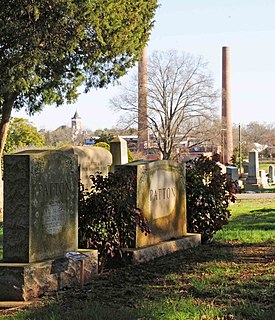
Laurelwood Cemetery is a historic cemetery located at Rock Hill, South Carolina. It was established in 1872, and was the first municipal cemetery of Rock Hill. It contains over 11,414 marked grave sites and includes variety of funerary art including a few raised stone tombs and a number of obelisks, table markers, spheres, and other forms. The cemetery also includes a Confederate monument and a memorial to veterans of the World War I.

Marion Street Area Historic District is a national historic district located at Rock Hill, South Carolina. It encompasses 28 contributing buildings and 1 contributing site in a middle-class residential section of Rock Hill. The bulk of the district developed between 1906 and 1925. Architectural styles represented include Victorian, Classical Revival, Colonial Revival, and Bungalow. Notable buildings include the Rawlinson House, McCall-Jones-Byrant House, Davis House, and W. B. Jenkins House.

Reid Street–North Confederate Avenue Area Historic District is a national historic district located at Rock Hill, South Carolina. It encompasses 22 contributing buildings in a middle-class residential section of Rock Hill. The district developed between about 1839 and 1935. Architectural styles represented include Victorian, Classical Revival, Queen Anne, and Bungalow. Notable buildings include the Steed House, Bynum House, Jenkins House, and Gross-Brock House, along with the separately listed White House.

Highland Park Manufacturing Plant and Cotton Oil Complex is a historic industrial complex and national historic district located at Rock Hill, South Carolina. It encompasses three contributing building and two contributing structures in Rock Hill. The complex includes the Highland Park Manufacturing Plant, the Highland Park Cotton Oil Mill (1902), and the Highland Park Cotton Oil Mill Office (1902). They are the surviving buildings of a larger complex, including a gin and seed house, the rest of which have been demolished. Surrounding the original mill are portions of the mill village. The mill operated until 1968.

Revolution Cotton Mills, also known as Revolution Division and Cone Mills, is a historic cotton mill complex located at Greensboro, Guilford County, North Carolina. The complex was built between 1900 and the mid-20th century and is an example of "slow burning construction." It includes 12 contributing buildings and 2 contributing structures. They include the main mill building, warehouses, weave room and machine shop, bleachery and dye room, storage/shipping/office building, and yellow brick chimney stack. The mill ceased operation in February 1982.





















